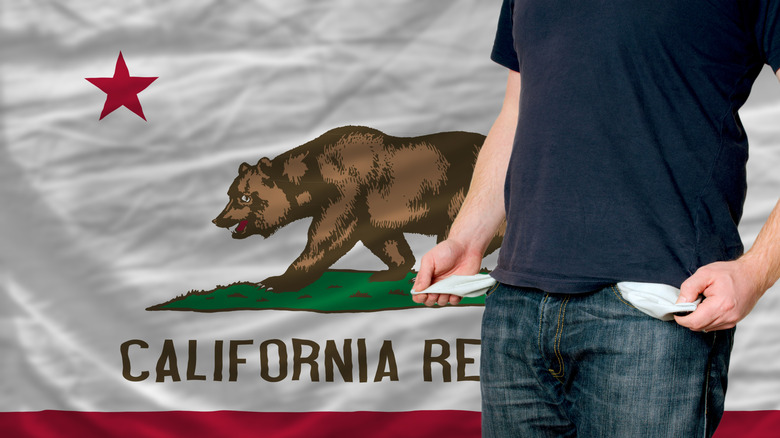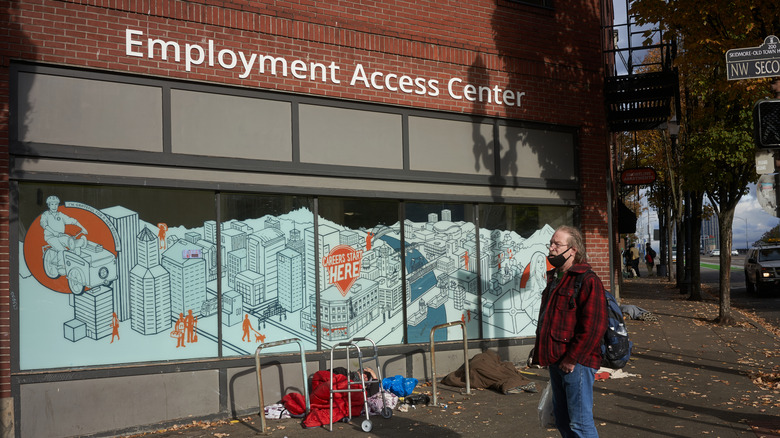12 US States With The Highest Unemployment Rates
According to data released by the Bureau of Labor Statistics (BLS) in August 2025, the national unemployment rate for the United States was 4.3%. While 22,000 new jobs were added in August, led by job gains in the healthcare industry, this did little to offset those who lost work in career fields related to oil, gas, and mining, as well as the mass layoff of federal employees.
Though this represents the national picture, it is increasingly clear that some regions of the United States are experiencing a sharper increase in unemployment claims and jobless rates than other areas. While some estimates place Washington, D.C., as the top area of the country hardest hit by unemployment, it's clear that at least a dozen states are seeing a rise in joblessness on the back of uncertainty regarding the economy, tariffs instituted by Trump, housing affordability, and the overall increase in cost of living.
Below are 12 states that currently account for the highest unemployment rates.
California
California is currently the U.S. state with the highest unemployment rate. As of August 2025, the Bureau of Labor Statistics estimated that 5.5% of Californians are out of work; the figure represents a 0.2% increase from state data released in September 2024. It also means that more than one million job seekers within the state are out of work. In reporting on the state's unemployment situation, CalMatters noted that the current figures might not tell the whole story. The BLS counts anyone working at least one hour per week as employed. With this in mind, the unemployed and underemployed estimates for the state push California to just shy of 10%, the highest out of every U.S. state.
In exploring the reasons for California's high unemployment rate, many point to issues impacting America as a whole: economic uncertainty due to trade policies, rising prices, and ongoing industry-wide layoffs. These all contribute to a domino effect — causing people to lose work, industries to shrink, and for there to be fewer roles available for everyone seeking work.
Some observers point to state-specific problems that contribute to California's high unemployment rate. The San Francisco Chronicle, for example, has tracked the layoff situation in the tech industry, which has affected thousands of workers in the Bay Area alone. In recent decades, California has become synonymous with the rise of Silicon Valley. As the industry continues to experience ongoing upheaval due to uncertainty around A.I. and other technology, it's possible the state finds itself in lock-step with its decline, adding to local employment woes.
Nevada
Though the BLS estimated Nevada's unemployment rate to stand at 5.3%, it's important to remember that the majority of the state's population is concentrated in Clark County, where Las Vegas is located. This metropolitan area is estimated to be home to 2.4 million residents, which is a 4% increase from 2020. While population numbers may be up, the region's available job roles have not increased, causing locals and recent transplants to the area to struggle against a high unemployment rate.
APM Research Lab collaborated with Marketplace to develop key economic indicators in an effort to create a clear picture of the problem and its causes. According to their findings, Nevada's unemployment crisis isn't strictly tied to tourism, a surprising outcome given how heavily the state relies on visitors and how the Las Vegas region suffered due to the 2020 pandemic shutdowns. Instead, the data showed that Las Vegas had shown steady and immediate growth when the pandemic shutdowns ended.
Per APM Research Lab, Stephen Miller, professor of economics and director of research at the Center for Business and Economic Research at the University of Nevada Las Vegas, offers a different possibility: That the high jobless rate may be the result of structural unemployment. This happens when workers are steadily moving away from certain sectors of the local economy into new ones. This creates a shortage of labor in some industries and a surplus in others, resulting in a lack of job roles for seekers currently demanding them. The biggest movement comes from former retail and hospitality industry workers navigating to other sectors, but especially toward information, construction, manufacturing, and government jobs. As people wait for more roles to become available in these industries, it is likely that unemployment figures will remain unchanged.
Michigan
At 5.3%, Michigan's unemployment rate is among the highest in the country, ranking 3rd behind California and Nevada and 4th when Washington, D.C. is included. As the Michigan Advance reports, the problem is worse in more rural areas of the state, where the amount of unemployed workers exceeds 6%.
In discussing the bleak outlook on the Reddit subreddit r/Michigan, one local said, "If the country sneezes, Michigan gets a cold." They went on to add, "Our state remains quite centered around a specific industry and is more intertwined with Canada than many other states. Both are greatly impacted by tariffs." Michigan is a state with decades-long ties to manufacturing, particularly the automotive industry. Likewise, the technology, healthcare, and finance sectors figure heavily in the state's economy.
Michigan is facing a situation in which demand for workers in some industries, such as construction and childcare, is high, but not enough workers are available. Per the Michigan Advance, poor pay and unfavorable labor laws may be keeping qualified candidates away from those industries, leading them to pursue roles in areas where demand is high but available positions are scarce. There is an expectation that the healthcare industry could create 25,000 new jobs in Michigan by 2032. However, there's no clear indication that this anticipated growth will reach the more rural areas or if the pivot to growing industries will happen fast enough to address ongoing unemployment concerns.
Oregon
Oregon's unemployment rate reached 5% in July 2025. It's at a level that, according to Oregon Public Broadcasting, the state hasn't seen since the COVID-19 shutdowns. It also represents a 0.8% increase from what was reported around the same time in 2024. The OPB likewise noted that the state's overall job market is shrinking, with 25,000 jobs disappearing within the last year. Gail Krumenauer, Oregon's chief employment economist, shared in a briefing that the manufacturing industry has been the hardest hit by layoffs, with 9,400 jobs lost in 2024.
Though manufacturing job losses accounted for nearly half of recent firings within the state, there was significant contraction in several other industries, including construction, private education, wholesale trade, and information technology. Intel alone accounted for 3,000 job losses in the area, including nearly 700 layoffs in November 2025. Other brands tied to mass layoffs include Safeway, Albertsons, and Wells Fargo.
Making things worse for Oregon workers is that there isn't any significant growth to offset the hemorrhaging of work opportunities in industries struggling against the current economic climate. For example, the healthcare, social assistance, and hospitality industries within Oregon collectively hired around 13,000 people. Despite some positive movement in these sectors, it's not enough to offset the ongoing job losses in other local industries.
Ohio
In August 2024, the BLS shared that Ohio's unemployment rate had climbed to 5%, up 0.6% year over year. It's a frustrating situation for the state, which reportedly invested billions of dollars in its employment infrastructure in the hopes of producing a significant turnaround in the local job market. For example, Ohio offered considerable tax breaks to top businesses and wealthy individuals in the hopes that they would invest heavily in the state and create significant job opportunities for Ohioans. The decision has cost the state around $1 billion per year since 2013, but hasn't resulted in the job growth that Ohio officials anticipated.
While some blame the ongoing unemployment crisis in the state on resources being largely siphoned off by a small percentage of wealthy businesses that have not significantly reinvested in the state, some point to the far-reaching impact of federal layoffs. In defending JobsOhio against criticism that it's not done enough to combat Ohio's high unemployment levels, spokesman Matt Englehart said, "Because of Ohio's large number of federal workers, those federal layoffs could have created a severe shock to Ohio's economy. Still, unemployment is only slightly elevated because of JobsOhio's focus on industrial diversity."
Despite Englehart's claims, others noted that federal workers accounted for only a small share of the state's employment woes. Meanwhile, Ohio's healthcare and manufacturing industries account for significant job losses. Overall, the state is still at a 100,000-job deficit compared to where it was when the COVID-19 pandemic began.
New Jersey
New Jersey has endured increasing unemployment levels over the last few years. In 2023, the New Jersey Monitor reported the rate was 4.7%; however, New Jersey's unemployment percentage has since peaked at 5% statewide. Meanwhile, some regions of the state are experiencing more severe levels of job loss. USAFacts revealed the 10 New Jersey counties with the highest unemployment rates, all of which sat at 5.7% or above. Things are the worst for Cumberland County residents, where the unemployment rate sits at 8.5%.
What may confuse some onlookers is why unemployment rates continue to go up in New Jersey. In 2023, the state added about 90,000 new jobs, with healthcare, government, and leisure industries accounting for the most significant growth. The answer may be in the fact that the positions filled in some sectors are not enough to offset losses elsewhere. As of June 2025, New Jersey accounted for the second-highest rate of joblessness for the construction industry, behind only Rhode Island. Year-over-year, construction businesses accounted for 10,000 jobs lost.
Despite ongoing unemployment concerns, there are signs that some industries within New Jersey are poised to see significant growth. Several industries have made gains, with private education, healthcare, professional and business services, leisure, and hospitality seeing the most noteworthy strides in career gains.
Massachusetts
The Bureau of Labor Statistics reported that the unemployment rate in Massachusetts was 4.8%. The state's jobless rate continues to climb above the national average, with no visible signs of leveling off. Previously, Massachusetts' unemployment level had declined to 3.3% in April 2023, the lowest level seen since the pandemic. However, unemployment claims are so high that there are fears the funds supporting out-of-work job seekers could soon run out as early as 2028, further devastating the local economy. One reason Massachusetts struggles with job creation is the notoriously high taxes businesses pay to the state, a portion of which goes into covering unemployment insurance. Another driving factor is thought to be employers' hesitancy to expand due to the feared impact of tariffs.
While high taxes and business costs might be contributing to a slowed job market, others believe the real issue isn't fewer jobs, but instead, a sharp rise in job seekers. Department of Economic Research Chief Economist Mark Rembert told WWLP that Massachusetts employers had added over 10,000 jobs between March and April 2025. "We haven't seen an uptick in layoffs or new unemployment claims," said Rembert, "meaning the uptick is being driven by more people entering the workforce and looking for work."
Kentucky
Kentucky's unemployment rate hit 4.7%, and research suggests there are several key factors contributing to a stagnant job market. As shared by the Kentucky Chamber Center for Policy & Research, there was a year-over-year increase in unemployed workers; however, data suggested that the main driver wasn't a decrease in the number of available jobs. University of Kentucky economist Mike Clark found that there were people who were successfully finding jobs; however, they were outpaced by the number of new workers seeking jobs, but failing to secure any. Said Clark, "Since workers are entering the labor force faster than they are finding jobs, the state's unemployment rate has also increased this year."
Another key contributor to the stagnant job market is that Kentucky workers are choosing to stay in roles rather than leave them. This low turnover creates a situation where roles that would otherwise open up through retirement or an employee opting for a better opportunity remain unavailable.
Alaska
While Alaska is by far the largest U.S. state by landmass, it's among the least populated, with just over 741,000 people calling it home. This is enough to drive home the fact that, while it has an unemployment rate of 4.7% like many other U.S. states, its smaller population means the situation is felt more keenly. The area of Alaska most affected by unemployment is reportedly the Kusilvak Census Area, with a rate of around 19.6%. By comparison, Anchorage, which accounts for the largest share of the state's labor force, has an unemployment rate of 3.3%.
Over the past few years, Alaska's fishing industry experienced a multibillion-dollar decline. What followed were multiple plant closures and 7,000 job cuts. The state's oil and gas industry is likewise suffering, with ConocoPhillips announcing layoffs that may halt or even reverse previously observed job growth. It wasn't all bad news for Alaskans, as the state added 2,900 new jobs, mainly in construction, healthcare, transportation, and warehousing and utilities. Some also hope that the seasonal nature of much of Alaska's job market means that things could always improve, at least over the course of the busiest months of the year.
Rhode Island
The 4.6% unemployment rate in Rhode Island is only part of the story. In March 2024, Rhode Island's unemployment rate stood at 4.0%. At the time, this represented a 48% increase over 12 months. Though the state has seen only a 0.6% increase in the number of unemployed workers a little over a year later, that growth still signals an acceleration of unemployment and suggests the Rhode Island economy is moving in the wrong direction. Some experts believe the state has already entered a recession, with the weak job market among the primary indicators.
As for the unemployment rate, some suggest that the BLS figure is an unreliable measure of Rhode Island's job market because it doesn't account for those who've opted out of the labor force entirely. It's also possible that the state's jobless rate is repeatedly impacted by the shrinking of the state's labor force relative to the number of jobs that happen to be available.
Washington
The number of unemployed workers in Washington held at 4.5%, and while this gives the state one of the highest rates of unemployment in the country, some view the percentage as proof that the problem has slowed significantly. According to data released by the state's Employment Security Department in August 2025, the state gained 4,800 jobs, which represents a 0.1% net increase from the previous year. That said, the state paid out unemployment benefits to 64,181 claimants in July.
Some experts also warn that certain demographics may be overrepresented among the state's unemployed. South Seattle College Georgetown's Labor Education and Research Center released data that suggests women have not participated in the Washington workforce at levels seen before the COVID-19 pandemic. This is especially true of mothers of young children. Their research also suggested that Black and multiethnic workers were more likely to be out of work.
In addressing the reason for Washington's above-average unemployment levels, some point to a backlog in claims brought on at least in part by the government shutdown, which left nearly one in three Washington workers temporarily out of work. Though the shutdown has since ended, the impact on Washington's already fragile economy is still being felt.
Lousiana
At 4.4%, Louisiana's unemployment rate sits slightly above the national average, though Federal Reserve Economic Data (FRED) released insight suggesting the rate might be level with the nation's 4.3% average. While Louisiana has more unemployed workers than most states, there has been a significant year-over-year drop in its rate of unemployment, which had risen to 4.8% in August 2024. The state is also down from the 11.7% rate experienced in March 2020, during the early days of the COVID-19 pandemic.
Though the latest data suggests that Louisiana is slowly moving in a positive direction, it might not be fast enough. In February 2025, reporting by WWLTV revealed that Louisiana was losing residents faster than almost every other U.S. state. One of the reasons for the mass migration elsewhere was the state's notoriously low job growth rate, which hasn't moved beyond 2% since 2000.
Despite the slow growth rate, the state has taken an aggressive approach to unemployment benefits. Out-of-work residents receive $275 per week at best, with the hope that the admittedly low amount will encourage them to reenter the job market as quickly as possible. It's likely that the lack of job prospects, coupled with poor support from the state, may continue to drive people to seek economic opportunities elsewhere.












